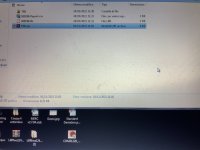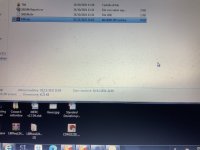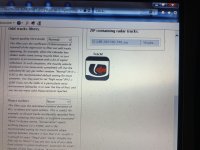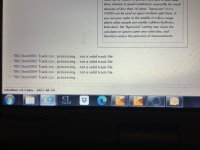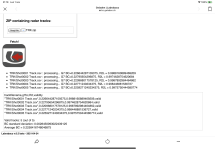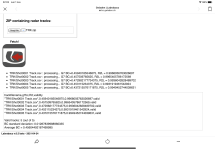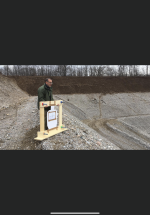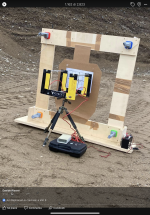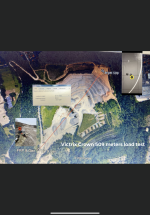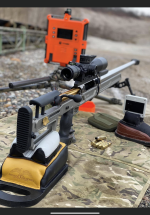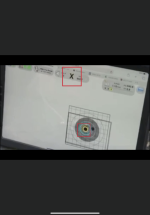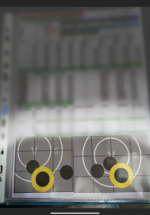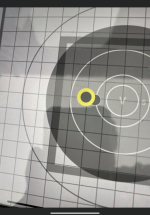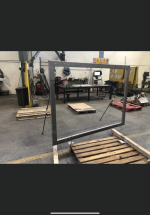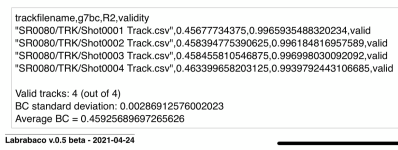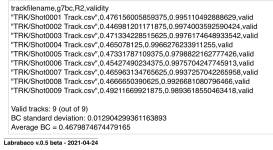Yes, it is possible. Yes, it does work.
I have put together some code to calculate G7 ballistic coefficients from Labradar tracks. The tool is available here: https://bc.geladen.ch/labrabaco/labrabaco.html
It all runs in your browser, there is nothing to install, and it's free and open source.
Some bits of additional info are here: https://geladen.ch/en/labrabaco-v-0-5-beta-is-out/
and here: https://geladen.ch/en/tips-to-set-up-labradar-for-the-most-awesomest-results/
My deepest gratitude goes to entoptics @ longrangehunting.com forums, who provided absolutely precious data for design and calibration of the algorithms.
That is what can be expected:
[**] Applied Ballistics For Long Range Shooting, 2nd ed.
“Ref BC” is a known good G7 BC from “BC src”. “Baco BC” lists the values calculated by labrabaco from radar tracks.
(Wish I had an adult-size Doppler radar to check if Hornady ELDM 6.5 147gr really behaves so differently from all other bullets tested.)
Gory details will follow in a separate article. In short, the software uses a 5th order polynomial regression weighted by SNR (absolute, not dB) on all data points for V(t), then runs an actual 3DOF ballistic engine in reverse to iterate to the best-fitting BC.
You're welcome.
I have put together some code to calculate G7 ballistic coefficients from Labradar tracks. The tool is available here: https://bc.geladen.ch/labrabaco/labrabaco.html
It all runs in your browser, there is nothing to install, and it's free and open source.
Some bits of additional info are here: https://geladen.ch/en/labrabaco-v-0-5-beta-is-out/
and here: https://geladen.ch/en/tips-to-set-up-labradar-for-the-most-awesomest-results/
My deepest gratitude goes to entoptics @ longrangehunting.com forums, who provided absolutely precious data for design and calibration of the algorithms.
That is what can be expected:
Bullet | ref BC | BC src | valid tracks | baco BC | diff, % |
|---|---|---|---|---|---|
| GP90 (Fass90) | 0.166 | CH armee | 15 | 0.167 | 0.7% |
| GP11 | 0.274 | CH armee | 16 | 0.270 | -1.4% |
| RUAG BALL 8.6 | 0.312 | vendor [*] | 7 | 0.316 | 1.1% |
| Lapua Scenar-L 7.62 155gr | 0.230 | vendor | 16 | 0.230 | 0.1% |
| GP90 (SG-553-LB) | 0.166 | CH armee | 14 | 0.166 | -0.1% |
| Hornady ELDM 6.5 147gr | 0.351 | vendor | 16 | 0.332 | -5.4% |
| Berger EOL 6.5 156gr | 0.347 | vendor | 4 | 0.352 | 1.3% |
| Hornady ELDM 5.56 73gr | 0.200 | vendor | 5 | 0.206 | 3.0% |
| Hornady ELDM 6.5 147gr | 0.351 | vendor | 5 | 0.337 | -4.1% |
| Hornady ELDX 6.5 143gr | 0.315 | vendor | 4 | 0.312 | -1.0% |
| Hornady ELDX 7 175gr | 0.347 | vendor | 19 | 0.353 | 1.6% |
| SMK 223 69gr | 0.169 | Litz [**] | 10 | 0.167 | -1.1% |
| Hornady ELDX 6.5 143gr | 0.315 | vendor | 7 | 0.315 | -0.1% |
| Hornady ELDX 7 175gr | 0.347 | vendor | 22 | 0.351 | 1.2% |
[*] from trajectory data[**] Applied Ballistics For Long Range Shooting, 2nd ed.
“Ref BC” is a known good G7 BC from “BC src”. “Baco BC” lists the values calculated by labrabaco from radar tracks.
(Wish I had an adult-size Doppler radar to check if Hornady ELDM 6.5 147gr really behaves so differently from all other bullets tested.)
Gory details will follow in a separate article. In short, the software uses a 5th order polynomial regression weighted by SNR (absolute, not dB) on all data points for V(t), then runs an actual 3DOF ballistic engine in reverse to iterate to the best-fitting BC.
You're welcome.
Last edited:

